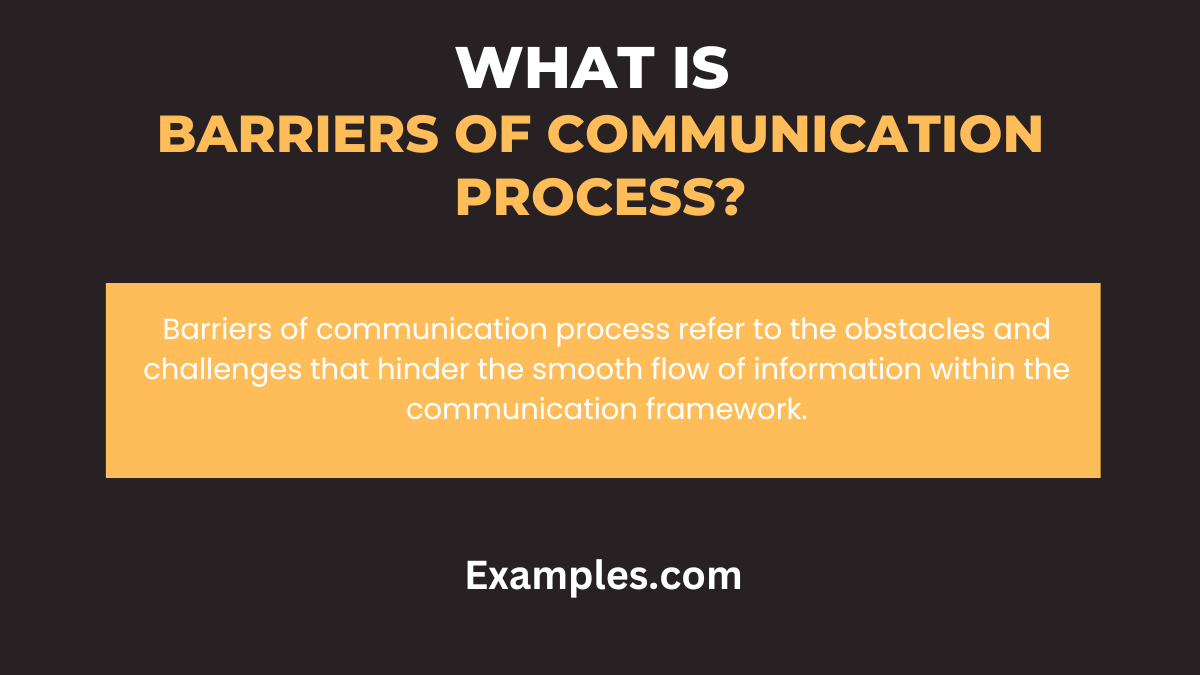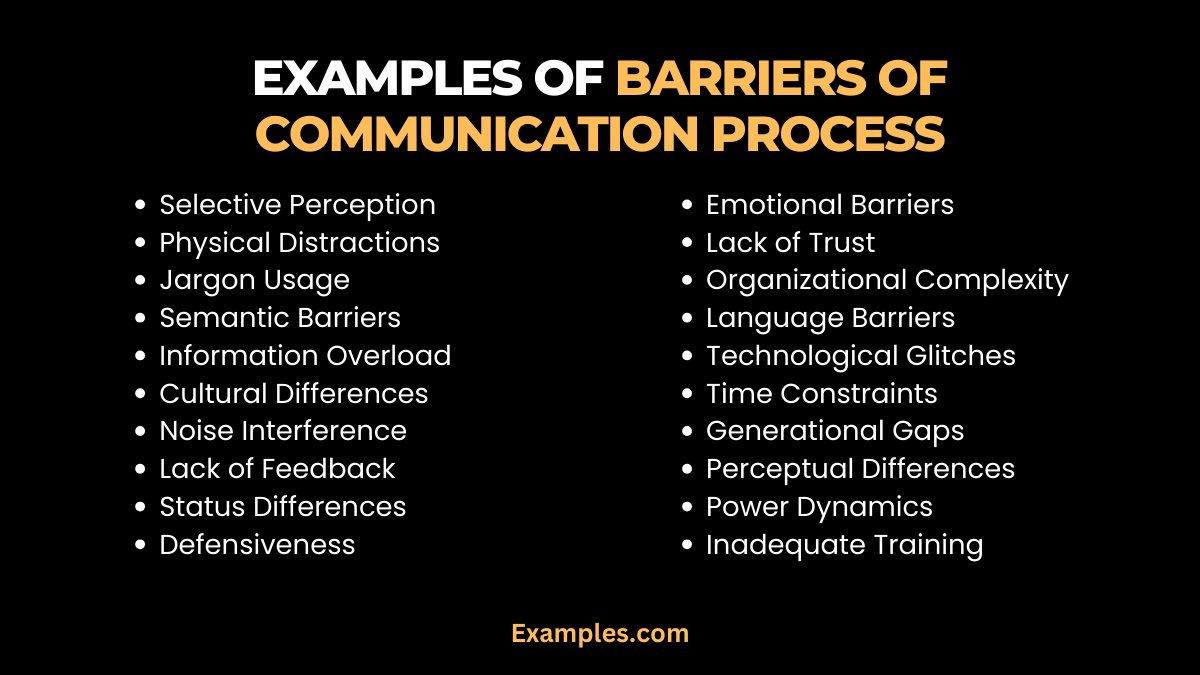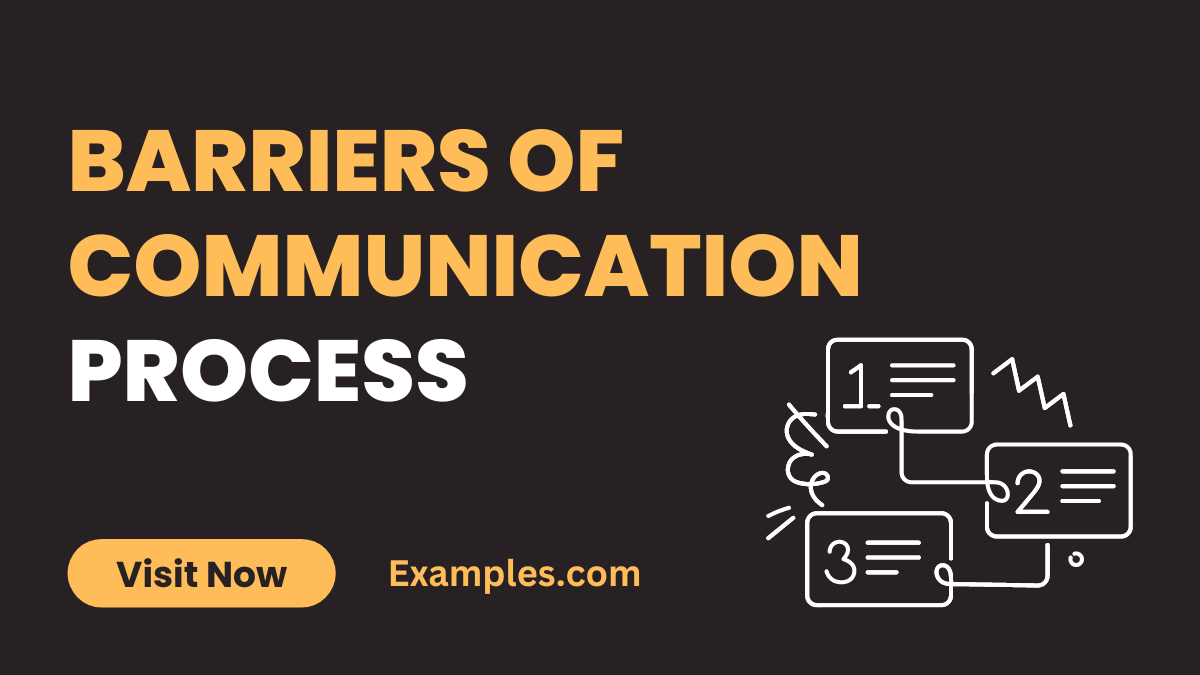Barriers of Communication Process
In the intricate landscape of communication, barriers pose formidable challenges. This exploration unfolds the definition, origin, and historical context of communication process barriers. Delve into illustrative examples to grasp their impact, and glean insights on overcoming these hurdles. Equip yourself with effective strategies, historical perspectives, and actionable tips, fostering a more adept and efficient communication process in diverse contexts.
What is Barriers of Communication Process?

20 Examples of Barriers of Communication Process

Barriers in the communication process, shedding light on hurdles that impede effective information exchange. This comprehensive guide provides insights into recognizing and overcoming these obstacles for enhanced communication efficiency.
- Selective Perception: Filtering information based on personal biases. To communicate effectively, encourage openness to diverse perspectives.
- Physical Distractions: External factors diverting attention. Overcome by choosing conducive environments for discussions.
- Jargon Usage: Specialized language hindering understanding. Simplify language for clarity in communication.
- Semantic Barriers: Different interpretations of words. Clarify meanings to avoid misunderstandings.
- Information Overload: Excessive data causing confusion. Prioritize key information for concise communication.
- Cultural Differences: Divergent cultural backgrounds impacting interpretation. Foster cultural sensitivity for clearer communication.
- Noise Interference: External disruptions affecting message reception. Minimize noise for effective communication.
- Lack of Feedback: Absence of response hindering understanding. Encourage regular feedback for clearer communication.
- Status Differences: Varied organizational ranks impacting openness. Promote a culture where all voices are valued.
- Defensiveness: Resistance to feedback hindering dialogue. Foster an open-minded approach for effective communication.
- Emotional Barriers: Emotional states impacting reception. Encourage empathy for better emotional understanding.
- Lack of Trust: Skepticism affecting information acceptance. Cultivate trust to enhance communication reliability.
- Organizational Complexity: Bureaucratic structures impeding information flow. Simplify processes for clearer communication.
- Language Barriers: Multilingual teams facing interpretation challenges. Promote language inclusivity for effective communication.
- Technological Glitches: Communication breakdowns due to technology. Ensure reliable tech infrastructure for seamless communication.
- Time Constraints: Limited time affecting message delivery. Prioritize and structure discussions for time-efficient communication.
- Generational Gaps: Differences in age impacting communication styles. Bridge gaps through understanding and adaptation.
- Perceptual Differences: Varied perspectives influencing interpretation. Encourage open discussions to align perceptions.
- Power Dynamics: Imbalances affecting free expression. Foster an environment where all team members feel empowered to communicate.
- Inadequate Training: Lack of communication skills impacting clarity. Invest in training for enhanced communication proficiency.
Barriers of communication process in the workplace
Effective communication within the workplace is fundamental for productivity and collaboration. This comprehensive guide navigates through common barriers hindering communication processes in professional settings. Explore practical strategies to overcome these hurdles, fostering a more adept and efficient communication framework within your workplace.
- Identifying Workplace Communication Process Barriers: Pinpoint barriers such as selective perception, cultural differences, jargon usage, and more that impede effective workplace communication processes.
- Understanding the Impact of Communication Barriers: Explore how these barriers affect workplace dynamics, productivity, employee morale, and overall organizational performance.
- Addressing Noise Interference and Physical Distractions: Learn to mitigate external disruptions by creating conducive environments and minimizing distractions for clearer communication.
- Navigating Cultural Diversity in Communication: Foster cultural sensitivity and inclusivity to bridge gaps caused by diverse cultural backgrounds among employees.
- Overcoming Semantic and Jargon-Related Barriers: Simplify language usage and clarify meanings to ensure everyone comprehends messages accurately.
- Encouraging Open Feedback and Active Listening: Establish a culture of open feedback and active listening to overcome barriers arising from lack of response or selective listening.
- Mitigating Emotional and Trust-related Hurdles: Cultivate trust and empathy to navigate emotional barriers that may hinder transparent communication.
- Aligning Organizational Complexity with Clear Communication: Simplify bureaucratic processes and encourage transparent communication to overcome organizational complexity barriers.
- Leveraging Technology for Effective Communication: Ensure reliable tech infrastructure and address glitches that hinder smooth communication processes in the digital workplace.
- Promoting Training and Skill Development: Invest in communication skill training to equip employees with the necessary tools to overcome barriers and enhance proficiency.
Barriers Of Communication In Teaching Learning Process
Effective communication skills are pivotal in the teaching-learning process. This guide navigates through barriers that hinder effective communication in educational settings, offering strategies to overcome them and foster an enriched learning environment.
- Identification of Communication Barriers: Explore barriers impeding effective teacher-student communication. Recognize challenges like language differences, distractions, and diverse learning styles.
- Overcoming Language Barriers: Multilingual classrooms pose challenges. Implement language-inclusive methods, visual aids, and language support tools to bridge communication gaps.
- Addressing Distractions and Noise: External disruptions hamper learning. Create conducive learning spaces and strategies to minimize distractions, enhancing communication clarity.
- Cultural Sensitivity in Communication: Diverse student backgrounds impact understanding. Foster cultural sensitivity to ensure inclusive and respectful communication practices.
- Adaptation to Learning Styles: Varied learning styles require tailored communication. Employ diverse teaching methods to cater to auditory, visual, and kinesthetic learners.
- Feedback and Encouraging Participation: Lack of feedback impedes progress. Create an environment where students feel encouraged to express and participate actively.
- Emotional Intelligence in Education: Emotional barriers affect learning. Develop emotional intelligence to address student emotions and facilitate effective communication.
- Technology Integration in Education: Leverage technology to enhance communication. Utilize interactive tools and platforms for engaging and effective digital communication.
- Time Management in Teaching-Learning: Time constraints hinder comprehensive communication. Structure lessons effectively to optimize communication within limited time frames.
- Promoting Trust and Openness: Trust fosters effective communication. Cultivate a trusting environment where students feel comfortable expressing themselves openly.
What are the effects of the barriers to everyday communication process?
Barriers in everyday communication can profoundly influence interactions, both in personal and professional spheres. Exploring the effects of these obstacles reveals their pervasive impact on relationships, productivity, and overall communication efficacy.
- Strained Relationships: Communication barriers strain relationships, fostering misunderstandings and eroding trust. This strain often leads to conflicts and strained interpersonal connections.
- Reduced Productivity: Ineffective communication processes impede workflow efficiency, leading to delays, errors, and misunderstandings. This ultimately impacts productivity and the attainment of goals.
- Increased Stress and Frustration: Barriers heighten stress levels, causing frustration among individuals attempting to convey or interpret messages. This heightened tension negatively impacts mental and emotional well-being.
- Missed Opportunities: When communication barriers hinder clear exchanges, opportunities for innovation, collaboration, and problem-solving diminish, leading to missed growth prospects.
- Poor Decision-Making: Ineffective communication influences decision-making processes. Misinterpreted or incomplete information leads to flawed decisions with potential long-term ramifications.
What are five barriers to effective communications in the workplace?
Effective workplace communication is pivotal for success. Explore these five common barriers hindering communication proficiency and learn strategies to bolster communication skills, ensuring a more cohesive and productive work environment.
- Lack of Clarity and Conciseness: Ambiguous messages hinder understanding. Develop clarity in communication by crafting concise and specific messages, ensuring information is easily comprehensible to all team members.
- Poor Listening Habits: Inattentiveness disrupts comprehension. Cultivate active listening skills by encouraging attentive engagement during conversations, fostering a culture of attentive and empathetic listening.
- Emotional Barriers and Conflict Avoidance: Unresolved emotions hamper dialogue. Address emotional barriers by creating a safe space for open discussions, fostering trust to navigate conflicts constructively.
- Technological Overload and Misuse: Overreliance or misuse of technology leads to miscommunication. Balance digital and face-to-face interactions, utilizing technology judiciously for effective communication.
- Hierarchical and Cultural Barriers: Organizational hierarchies and cultural differences impact communication. Promote open dialogue irrespective of rank and encourage cultural sensitivity to bridge communication gaps.
In conclusion, unraveling the intricacies of communication process barriers is pivotal for fostering effective interactions. By exploring examples and strategies in this comprehensive guide, individuals and organizations can transcend obstacles, enhancing their communication proficiency. Armed with practical insights, this guide serves as a compass, navigating the complexities of communication processes for clearer, more impactful communication.



